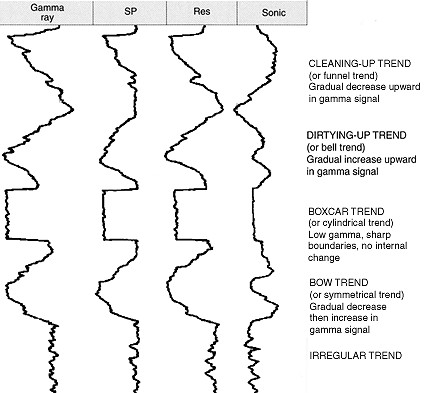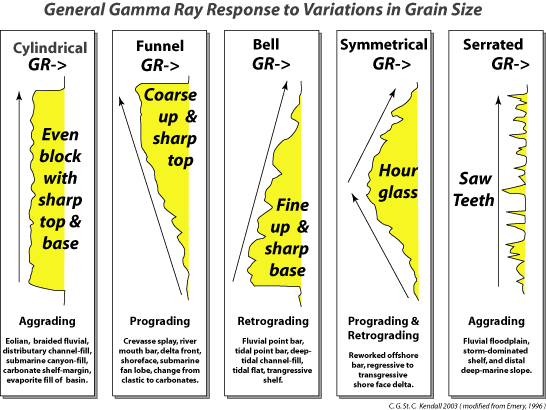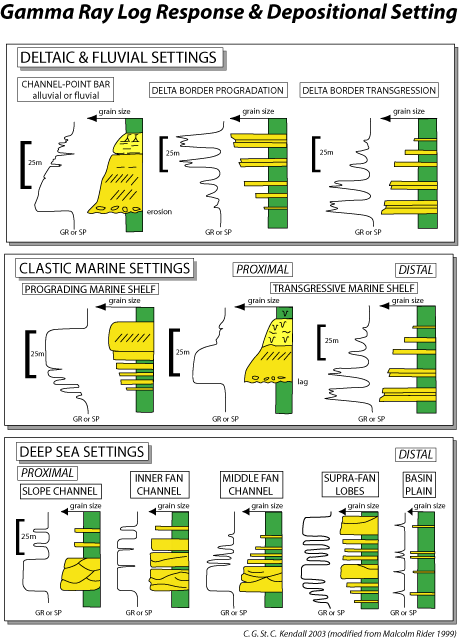
(source: Emery, 1996)
There are three general trends or curve shapes that can be recognized when looking at well log curves. For instance the
gamma log tracks the upward change in
clay-mineral content.
NB: whenever possible, one should use core data to confirm or augment well log analysis. This because core provides direct access to the character of the rock penetrated by the well whereas well logs are used to infer the character of the rocks penetrated. Care in establishing and matching the depths of the core and well logs is essential in the correlation of well logs and core.
Gamma Ray Response as a proxy for grain size
Variation in GR log character
is interpreted to be a proxy for grain size and so enable these logs to play a
major role in the sequence stratigraphy analysis. The rationale behind this interpretation is
that variations in the GR are related to the presence of organic matter that sequesters
radioactive minerals responsible for the GR signal. In this case it is possible to: 1) identify the portions of the section which
had higher accumulations of organics and 2) those for which this has been
reduced by winnowing and oxidizing effects! In turn, the presence or absence of
organic matter is assumed to be a proxy for the winnowing and oxidizing effects
of shallow marine waters.
The result is that abrupt changes in the GR log
response were interpreted to be related to sharp lithological breaks associated
with unconformities and sequence boundaries (Krassay, 1998). The principle GR
log shapes were frequently used for interpreting the depositional setting of sedimentary
cycles.

- Cleaning-up trend (funnel shape): a gradual upward decrease in gamma response. In shallow marine settings, this trend reflects a change from shale-rich into sand-rich lithology and upward increase in depositional energy with shallowing-upward and coarsening. In deep marine settings, this trend reflects an increase in the sand contents of turbidite bodies. This trend also may indicate gradual change from clastic to carbonate deposition.
- Dirtying-up trend (bell shape): a gradual upward increase in gamma response: This trend may reflect upward fining (eg: a lithology change from sand to shale) or upward fining of sand beds in a thinly interbedded sand-shale unit. This trend usually implies a decrease in depositional energy. In a non-marine setting, fining upward is predominant within meandering or tidal channel deposits with an upward decrease in fluid velocity within a channel (coarser sediments at base of channel). In a shallow-marine setting, this trend usually reflects an upward deepening and a decrease in depositional energy (shoreline retreat). In deep-marine settings, this trend reflects waning of submarine fans (reducing of sand contents).
- Boxcar trend (cylindrical or block shape): with low gamma and sharp boundaries and no internal change: this trend is predominant in fluvial channel sands, turbidites (typically with greater range of thickness), and aeolian sands. evaporites also can have a cylindrical gamma trend.
Additionally two in-between trends can be recognized:
- Bow trend (symmetrical or barrel): with gradual decrease then gradual increase in gamma response: this is usually the result of progradation and retrogration of clastic sediments.
- Irregular trend (lack of character): this trend represents aggradation of shales or silts and can occur in other settings.
Curve character can be smooth, complex or serrated (sawlike) with contacts can be sudden or gradual.
The figure below summarizes the log response a variety of different clastic depositional systems that Malcolm Rider (1996) assembled in his excellent book on Well Logs. His diagram has been added to and slightly been modified for this web site.

References
Krassay, A.A., 1998. Outcrop and drill core
gamma ray logging integrated with
successions of northern Australia. AGSO Journal of Australian Geology
and Geophysics 17(4), 285-299.
Rider, M. 1986. The geological interpretation of well logs. Blackie, Halsted
Press, New York, 175 pp.